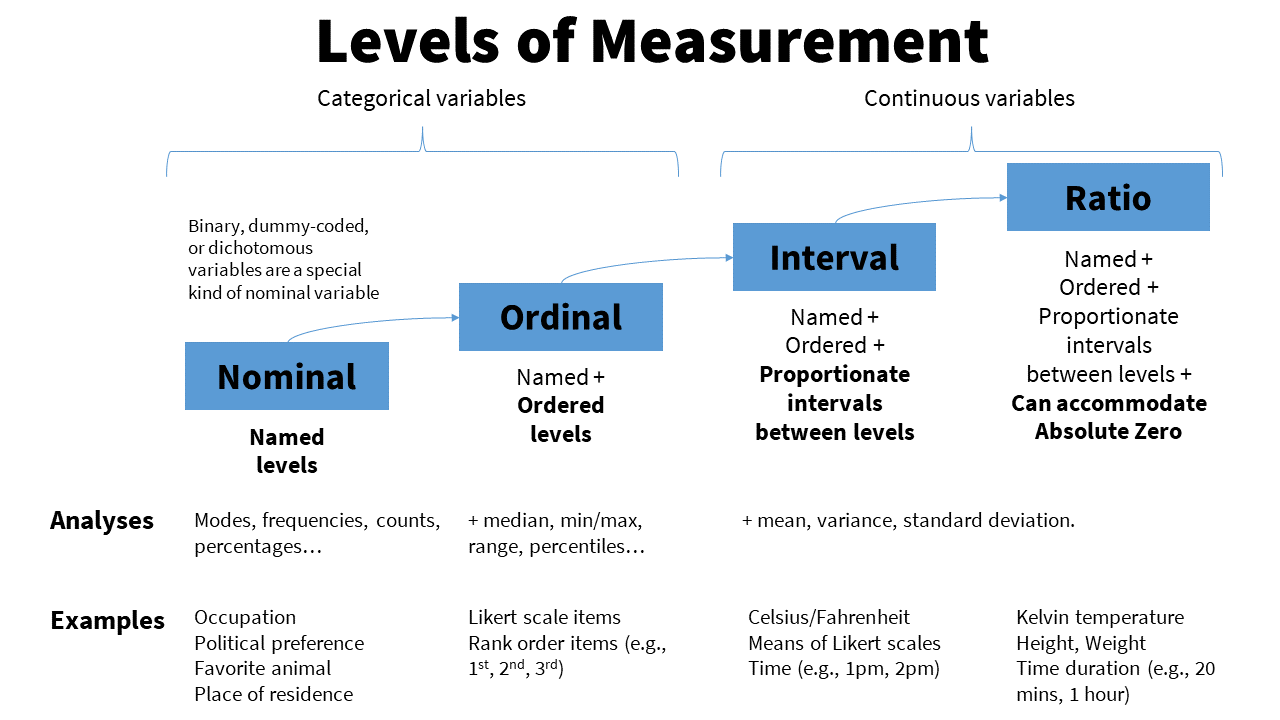Levels of measurement
This should be refresher material for you, but it is extremely important you are familiar with the four levels of measurement.

Categorical: variables that have categories to the levels, but cannot be analyzed with a mean because the levels are not proportionate. There are two types of categorical variables:
Nominal: a categorical variable in which each level of the variable is named but there is no order to them (e.g., breeds of dogs)
- Binary, dummy-coded, or dichotomous: a nominal variable with only two levels (general 0 or 1). This is a special type of nominal variable.
Ordinal: a categorical variable in which each level of the variable is named and there is an order to them (e.g., ranks)
Continuous: variables with proportionate intervals between the levels meaning they can be analyzed with a mean, SD, variance. There are two types of continuous variables (although for the purpose of this course we will simply call them continuous variables):
Interval: a continuous variable that has intervals that are directly proportionate (e.g., the distance between 2-3 is the same as the distance between 5-6)
Ratio: a continuous variable like an internal variable but can accommodate an absolute zero, meaning a zero is actually possible (e.g., weight, temperature in Kelvin, reaction time)
Examples of levels of measurement
Confused still on the levels of measurement? Maybe this will help! Notice that studying can be measured at different levels. Depending on the nature of the question and response options, it might be nominal, ordinal, or continuous! Here’s an example of data at the continuous, ordinal, and nominal level.
| Name | Study_Continuous | Study_Ordinal | Study_Nominal |
|---|---|---|---|
| Name (Character) | Hours studied per day | Likert scale of amount of studying | Whether or not they study every day |
| Jesus | 5.0 | A great deal | Yes |
| Nicky | 4.5 | A great deal | Yes |
| Bradford | 3.2 | A moderate amount | Yes |
| Sylvia | 1.7 | A small amount | Yes |
| Martha | 0.2 | Rarely | Yes |
| Lillian | 0.0 | Never | No |
| Trayvon | 0.0 | Never | No |
We can make any continuous variable into an ordinal and nominal variable and any ordinal variable into a nominal variable. But if we have a nominal variable we cannot make it ordinal, nor can we make an ordinal variable continuous. In other words, continuous variables contain more information. Often, we want to avoid losing information and always keep the variable at the highest level of measurement. Continuous has more information than ordinal has more information than nominal.
Another way to put it: never do a median split and avoid “collapsing” categories when you can. You’re losing information from your data by doing so.